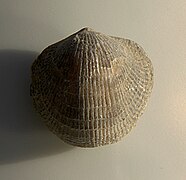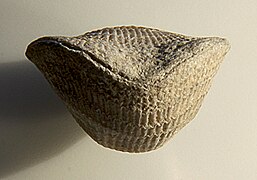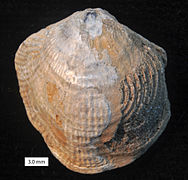
Lingula is a genus of brachiopods within the class Lingulata. Lingula or forms very close in appearance have existed possibly since the Cambrian. Like its relatives, it has two unadorned organo-phosphatic valves and a long fleshy stalk. Lingula lives in burrows in barren sandy coastal seafloor and feeds by filtering detritus from the water. It can be detected by a short row of three openings through which it takes in water (sides) and expels it again (middle).

Strophomenida is an extinct order of articulate brachiopods which lived from the lower Ordovician period to the mid Carboniferous period. Strophomenida is part of the extinct class Strophomenata, and was the largest known order of brachiopods, encompassing over 400 genera. Some of the largest and heaviest known brachiopod species belong to this class. Strophomenids were among the most diverse and abundant brachiopods during the Ordovician, but their diversity was strongly impacted at the Late Ordovician mass extinction. Survivors rediversified into new morphologies in the Silurian, only to be impacted once again at the Late Devonian mass extinction. However, they still survived till the mid Carboniferous.

Platyceras is a genus of extinct Paleozoic sea snails, marine gastropod mollusks in the family Platyceratidae. This genus is known from the Silurian to the Middle Triassic periods and especially abundant in the Devonian and Carboniferous. It is the type genus of the family Platyceratidae.

Brachiopods, phylum Brachiopoda, are a phylum of trochozoan animals that have hard "valves" (shells) on the upper and lower surfaces, unlike the left and right arrangement in bivalve molluscs. Brachiopod valves are hinged at the rear end, while the front can be opened for feeding or closed for protection. Two major categories are traditionally recognized, articulate and inarticulate brachiopods. The word "articulate" is used to describe the tooth-and-groove structures of the valve-hinge which is present in the articulate group, and absent from the inarticulate group. This is the leading diagnostic skeletal feature, by which the two main groups can be readily distinguished as fossils. Articulate brachiopods have toothed hinges and simple, vertically oriented opening and closing muscles. Conversely, inarticulate brachiopods have weak, untoothed hinges and a more complex system of vertical and oblique (diagonal) muscles used to keep the two valves aligned. In many brachiopods, a stalk-like pedicle projects from an opening near the hinge of one of the valves, known as the pedicle or ventral valve. The pedicle, when present, keeps the animal anchored to the seabed but clear of sediment which would obstruct the opening.
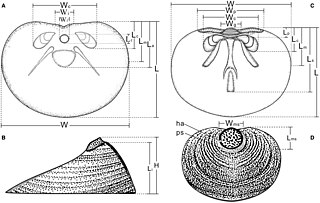
Acrotretides (Acrotretida) are an extinct order of linguliform brachiopods in the class Lingulata. Acrotretida contains 8 families within the sole superfamily Acrotretoidea. They lived from the Lower Cambrian to the Middle Devonian, rapidly diversifying during the middle Cambrian. In the upper Cambrian, linguliforms reached the apex of their diversity: acrotretides and their relatives the lingulides together comprised nearly 70% of brachiopod genera at this time. Though acrotretides continued to diversify during the Ordovician, their proportional dominance declined, as rhynchonelliforms took on a larger role in brachiopod faunas.

Rhynchonelliformea is a major subphylum and clade of brachiopods. It is roughly equivalent to the former class Articulata, which was used previously in brachiopod taxonomy up until the 1990s. These so-called articulated brachiopods have many anatomical differences relative to "inarticulate" brachiopods of the subphyla Linguliformea and Craniformea. Articulates have hard calcium carbonate shells with tongue-and-groove hinge articulations and separate sets of simple opening and closing muscles.

The Rhynchonellata is a class of Lower Cambrian to Recent articulate brachiopods that combines orders from within the Rhynchonelliformea with well developed pedicle attachment. Shell forms vary from those with wide hinge lines to beaked forms with virtually no hinge line and from generally smooth to strongly plicate. Most all are biconvex. Lophophores vary and include both looped and spiraled forms. Although morphologically distinct, included orders follow a consistent phylogenetic sequence.

Pentamerida is an order of biconvex, impunctate shelled, articulate brachiopods that are found in marine sedimentary rocks that range from the Middle Cambrian through the Devonian.

Sharpirhynchia sharpi is a species of extinct, small-sized lampshell, named after Samuel Sharp (1814–1882), an early fossil collector, who discovered the limited time span of some fossils, now known as index fossils. S. sharpi is a marine rhynchonellate brachiopod in the family Rhynchonellidae. It is roughly ½ inch (1.25 cm) measured along the axis, with a slender beak, the brachial valve more convex than the pedunculate valve, and it has 21–31 ribs fanning out from the hinge.

Rhynchonelloidella alemanica is a species of extinct, small-sized brachiopod, a marine rhynchonellate lampshell in the family Rhynchonellidae. It is roughly 1.4 cm (0.55 in), and has about 15 ribs fanning out from the hinge.

Athyris is a brachiopod genus with a subequally biconvex shell that is generally wider than long and a range that extends from the Silurian into the Triassic. Athyris is the type genus for the Athyrididae, which belongs to the articulate order Athyridida. R.C. Moore (1952) gives a shorter range, from the Mid Devonian to the Lower Mississippian.

Paterinata is an extinct class of linguliform brachiopods which lived from the lower Cambrian ("Tommotian") to the Upper Ordovician (Hirnantian). It contains the single order Paterinida and the subfamily Paterinoidea. Despite being some of the earliest brachiopods to appear in the fossil record, paterinides stayed as a relatively subdued and low-diversity group even as other brachiopods diversified later in the Cambrian and Ordovician. Paterinides are notable for their high degree of convergent evolution with rhynchonelliform (articulate) brachiopods, which have a similar set of muscles and hinge-adjacent structures.
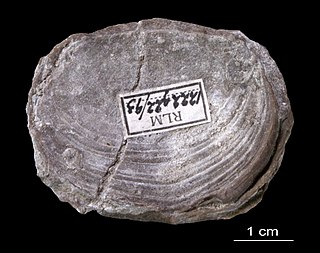
Trimerellida is an extinct order of craniate brachiopods, containing the sole superfamily Trimerelloidea and the families Adensuidae, Trimerellidae, and Ussuniidae. Trimerellidae was a widespread family of warm-water brachiopods ranging from the Middle Ordovician to the late Silurian (Ludlow). Adensuidae and Ussuniidae are monogeneric families restricted to the Ordovician of Kazakhstan. Most individuals were free-living, though some clustered into large congregations similar to modern oyster reefs.

Cyrtospirifer is an extinct genus of brachiopods. The fossils are present in the Middle and Upper Devonian.

Argyrotheca is a genus of very small to minute lampshells. All species share a large pedicel opening, one ridge on the inside of the pedunculate valve, pits in a diamond pattern on the inside of both valves, and without radial ridges that end in tubercles. It occurs in depths between 6 and 1300 m. It is known since the latest Cretaceous.

Dallina is a genus of small to average size lampshells. It is known since the Miocene.
Craniopsidae is an extinct family of craniiform brachiopods which lived from the mid-Cambrian to the Lower Carboniferous (Tournaisian). It is the only family in the monotypic superfamily Craniopsoidea and the monotypic order Craniopsida. If one includes the ambiguous Cambrian genus Discinopsis, craniopsids were the first craniiforms to appear, and may be ancestral to craniids and trimerellides. An even earlier Cambrian genus, Heliomedusa, has sometimes been identified as a craniopsid. More recently, Heliomedusa has been considered a stem-group brachiopod related to Mickwitzia.

Siphonotretida is an extinct order of linguliform brachiopods in the class Lingulata. The order is equivalent to the sole superfamily Siphonotretoidea, itself containing the sole family Siphonotretidae. Siphonotretoids were originally named as a superfamily of Acrotretida, before being raised to their own order.

Kutorginates (Kutorginata) are an extinct class of early rhynchonelliform ("articulate") brachiopods. The class contains only a single order, Kutorginida (kutorginides). Kutorginides were among the earliest rhynchonelliforms, restricted to the lower-middle part of the Cambrian Period.
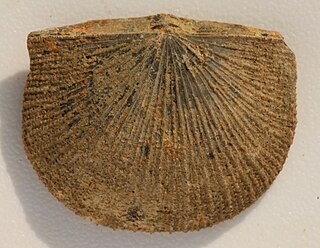
The orthotetides (Orthotetida) are an extinct order of brachiopods in the class Strophomenata. Though not particularly diverse or abundant relative to strophomenides (Strophomenida) or productides (Productida), orthotetides were nevertheless the longest-lasting order of strophomenates, surviving from the Middle Ordovician (“Llanvirn”) up until the Late Permian. Externally, many orthotetides are difficult to distinguish from strophomenides. Most fundamental differences between the two orders are internal: orthotetides have more elaborate cardinal processes and a greater diversity of shell microstructure.


